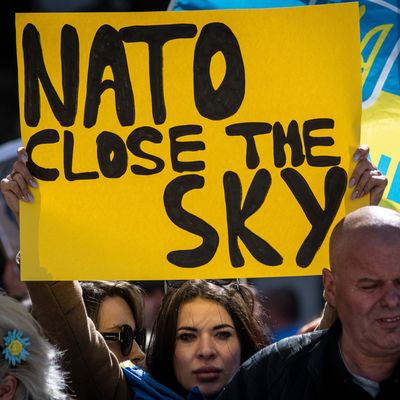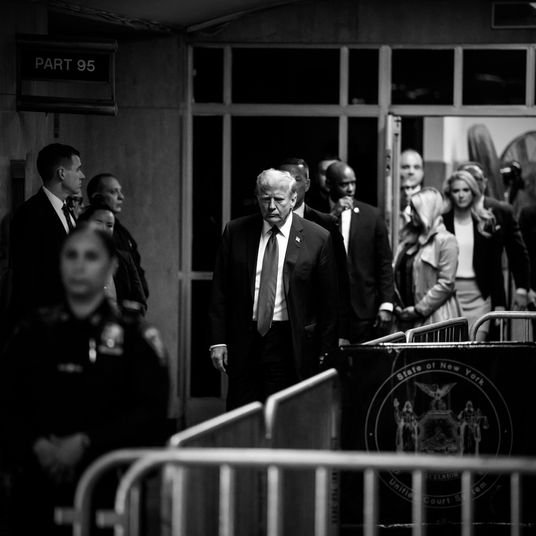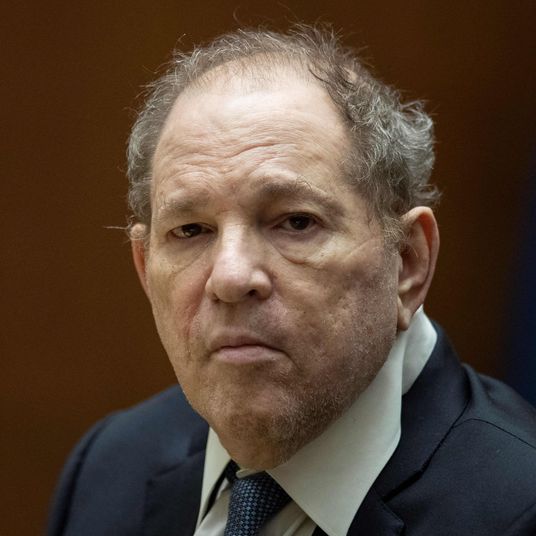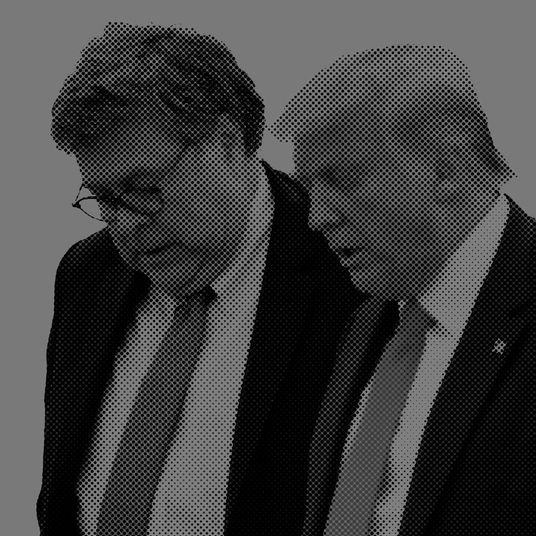
In less than two weeks of war, the Russian military has killed at least 406 Ukrainian civilians. That official United Nations tally is almost certainly a dramatic undercount. And the bloodletting has just begun.
In the first stage of its invasion, Russia sought to swiftly conquer Kyiv at a minimal cost to noncombatant lives. Believing that Ukrainians felt little loyalty to their government or national identity and that their military might therefore fold at the mere prospect of war with a greater power, the Kremlin attempted to conquer territory with small, isolated groups of paratroopers. Now that it understands the depths of Ukrainians’ resistance to domination, Russia is embracing increasingly brutal forms of warfare. It is shelling civilian infrastructure and besieging major cities. Ukrainian president Volodymyr Zelenskyy told his constituents Monday to expect further rounds of urban bombardment in the hours and days to come.
The West hasn’t been a mere spectator to these horrors. To punish Russia’s aggression, the United States and European Union have waged financial war on Russia. Sanctions have devastated the Russian economy and limited the Putin regime’s martial capacities at a substantial cost to western investors and consumers. Nevertheless, neither these economic measures nor the provision of weapons to Ukrainian forces have been sufficient to repel Russia’s troops or stanch Ukraine’s bleeding. As Russia ramps up its assault on Kyiv, Ukraine’s leaders and sympathizers have called on the West to aid the nation’s resistance more directly — by establishing a “no-fly zone” over Ukraine.
This request is understandable. But it’s also deeply unwise.
For many lay observers, the appeal of a no-fly zone derives largely from its euphemistic branding. The term describes a desirable outcome — in which no war planes can enter Ukrainian airspace — rather than the concrete measures NATO would immediately take in pursuit of that objective. Enforcing a no-fly zone would require NATO forces to shoot down any Russian planes that fly over Ukraine. And that is not the full extent of the idea’s perils. As retired U.S. Air Force general and no-fly-zone proponent Philip Breedlove acknowledges, enforcement would require neutralizing Russia’s capacity to fire missiles into Ukrainian airspace from its own territory; in other words, it would require NATO fighters to conduct bombing raids over Russia. Which would mean a hot war between nuclear-armed great powers.
For Ukraine’s embattled leadership, this broadening of the present conflict is likely the point. As of this writing, the bulk of Ukrainian civilian casualties appears to have come from attacks by Russian artillery, not Russian airstrikes. Given that Russia has yet to establish air superiority in Ukraine but is nevertheless steadily gaining territory, merely neutralizing Russian airpower would likely be insufficient to ensure Ukraine’s military victory. To deal Putin a decisive defeat, Ukraine needs NATO’s full backing. In practice, a no-fly zone would function as a means of easing western powers into a war with Russia.
In an op-ed for the New York Times, Zelenskyy’s chief-of-staff, Andriy Yermak, acknowledged that a no-fly zone could function as a warm-up for a wider war but insisted that such a conflagration is inevitable in any case. “We are calling on the West to impose a no-fly zone over Ukraine,” Yermak wrote. “We recognize that this would be a serious escalation in the war and that it could bring NATO into direct conflict with Russia. But we firmly believe that Russia won’t stop at just Ukraine, which would potentially drag NATO into this conflict anyway.”
The idea that failure to confront Russia in Ukraine will imperil peace far beyond its borders has become a central pillar of the case for a no-fly zone. Yermak reiterated it at the end of his column, arguing that, if the West fails to stop Putin now, “this war could be a prologue to a greater European or even global massacre.”
Senator Joe Manchin quoted Zelenskyy’s rendition of the point on Meet the Press on Sunday while imploring the White House to consider a no-fly zone. Manchin said “the free world” would be wrong to “hesitate” in coming to Ukraine’s aid since “if Ukraine falls, then Europe may fall.”
A variation on this point has currency among some left-wing thinkers who sympathize with Kyiv’s plight. John Jay College professor and The Nation contributor Nathan Newman argued Sunday that the slippery-slope argument against confronting Russia in Ukraine risks taking the world down a different slippery slope. “The logic of ‘a nuclear power can not intervene to stop an illegal invasion by another nuclear power’ basically means that the US, Russia, China, India, Pakistan, Britain, France and Israel de facto have the right to invade other countries at will,” Newman observed on Twitter.
It is not hard to understand why the no-fly-zone argument has evolved in this way. The hazards of a war between NATO and Russia are vast and undeniable. Great-power conflicts in Eurasia claimed the lives of over 100 million people last century, and nearly all of those deaths came in the preatomic age. Today, war between Russia and Western Europe would jeopardize nothing less than humanity’s long-term survival.
Justifying that gamble is not easy. One could argue that the true constraint on the world’s nuclear powers is mutually assured destruction and that a war between NATO and Russia would not erode that fundamental deterrent. In other words, U.S. planes bombing Russian installations in Belarus will not change the fact that Putin can’t order a nuclear strike without imperiling all of Moscow.
But historical experience tells us war has an escalatory logic that can lead rational actors into spectacular acts of self-destruction. An exchange of conventional military strikes could give way to “tactical” nuclear bombings, which could give way to Armageddon. Furthermore, even if the combatants manage to keep themselves off the upper rungs of that escalatory ladder, they could still cause death on a massive scale. Therefore, the imperative to avoid a general European war is so great that Ukraine’s present suffering alone — though horrifying and abominable — cannot override it.
But if it were true that NATO’s abstention from Ukraine would also lead to World War III, then this trade-off between defending Ukrainian sovereignty and safeguarding global security would disappear. In the narrative promoted by Zelenskyy and Manchin, allowing Russia to win a war of aggression against Ukraine would embolden Putin, along with other renegade nuclear-weapons states, to pursue further wars of conquest. According to this argument, forswearing confrontation with Putin today would not avert a world war tomorrow but only enable Russia to enter that war in a more favorable position. This reasoning leans heavily on an analogy between Putin’s Russia and Nazi Germany, a comparison Zelenskyy has made explicitly.
This analogy, however, is specious, and the broader argument is weak. Putin’s invasion still poses a threat to Ukraine’s sovereignty and citizenry. But it no longer threatens to increase Russia’s geopolitical strength nor to serve as an encouraging example to other revanchist powers.
Contrary to Putin’s intentions (and Zelenskyy’s Nazi allusions), Russia did not take Kyiv in a blitzkrieg that exposed the West’s underestimation of Moscow’s military might. In reality, Russia has done much the opposite, embroiling itself in a protracted conflict it cannot win on its desired terms while simultaneously exposing and greatly deepening its military weakness in the process.
Nearly two weeks into its invasion, Russia hasn’t been able to secure command of Ukraine’s airspace despite boasting nearly ten times as many planes as the Ukrainian air force. This failure apparently derives from Russia’s limited stockpile of precision-guided missiles (with which to take out Ukrainian radar installations and airfields) and experienced pilots (with whom to keep embattled planes aloft). And both of those limitations are likely a product of Russia’s fundamental economic weakness. The Kremlin boasts the nuclear arsenal of a great power but a GDP smaller than Italy’s. Its military budget amounted to roughly $60 billion in 2020, just $10 billion more than Germany’s and less than one-tenth of America’s. Meanwhile, the kleptocratic nature of Putin’s regime likely prevents that $60 billion from being optimally spent. Corruption has evidently compromised the Russian military’s logistical prowess, leaving infantrymen with substandard equipment and inadequate rations. The Kremlin’s much-hyped cyberwarfare capacities have proved no match for Microsoft.
If the war in Ukraine has revealed the Russian military’s preexisting defects, it has also exacerbated those liabilities. Already, Russia has lost at least 800 pieces of military hardware including 120 tanks, ten helicopters, and ten planes. Those figures are limited to losses that independent observers have managed to visually confirm. If the Ukranian military’s official tallies are to be believed, Russia’s losses are vastly higher.
In any case, the immediate depletion of Russia’s military resources is less significant than the devastation of its economy. Thanks to western sanctions, Russia’s GDP is poised to shrink by 7 to 15 percent this year depending on which estimate you believe. During Russia’s last major economic calamity — its 1998 debt crisis — the nation’s economy contracted by 5.3 percent.
Even before this war, Russia lacked the economic might necessary for posing a conventional military threat to the E.U., U.S., or any other major power. And it is certain to emerge from Ukraine drastically weaker and facing a more unified and militarily robust European Union (Germany has already committed to increasing its defense budget by $100 billion). This would be more true — not less — in the event of a decisive Russian “victory,” which would burden Putin’s armed forces with the depleting task of defending a puppet government against a perpetual Ukrainian insurgency.
Russia is increasingly aware of its own weakness. Far from expanding Putin’s imperial ambitions, the war in Ukraine has narrowed them. On Monday, the Kremlin dropped its demand for regime change in Kyiv, asking instead for recognition of Ukraine’s breakaway provinces as independent republics and a constitutional amendment that would forbid Ukraine from joining NATO or the E.U. This is a large comedown from the expansive war aims Putin articulated at the conflict’s outset and is broadly similar to the concessions Russia sought before it brought military force to bear on Kyiv.
In light of these developments, it is not credible to suggest that the fall of Ukraine would presage the fall of Europe. Nor is there much basis for the claim that failure to confront Russia in Ukraine will inspire aggression from other nuclear-armed states. The West has not risked nuclear war to defend against wars of conquest. But it has sacrificed its own economic best interests toward that aim and established a formidable deterrent against offensive wars in the process. To the extent that Putin’s Ukraine adventure has influenced Xi Jinping’s plans for Taiwan, it has surely made the prospect of war less attractive to Beijing.
All of which is to say: There is no basis for believing that NATO’s abstention from direct involvement in Ukraine will imperil the rest of Europe or the international order writ large. By contrast, any attempt to establish a no-fly zone would guarantee a war between Europe’s great powers. Ironically, the apparent weakness of Russia’s conventional forces only makes the Kremlin a more dangerous player in any great-power war: If Russia cannot compete with NATO on the strength of its conventional military resources, its incentive to deploy nuclear weapons will be all the greater. To advance the best interests of the Ukrainian people without jeopardizing those of humanity writ large, the West must push for a negotiated settlement, not shoot Russian planes from the sky.
More on ukraine
- House Passes Ukraine, Israel Aid: How It Happened
- Trump’s Plan for Every Foreign-Policy Problem Is Himself
- Putin Is Winning — and He’s Flaunting It






























